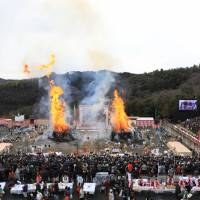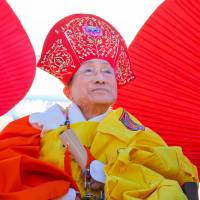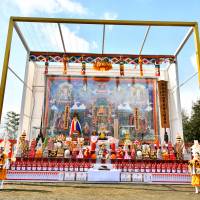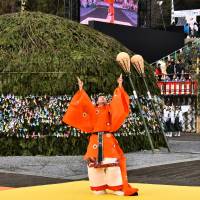The Agon Shu Buddhist Association’s Fire Rites Festival had two themes this year. The whopping 400,000 people who attended the festival in Kyoto on Feb. 11 were encouraged to pray for world peace and wish for individual happiness.
Given the current state of the world, that message couldn’t be timelier. Despite such concerns, the mood at the Fire Rites Festival was joyous and celebratory as always. For the Agon Shu faithful, the event is a kind of spiritual homecoming, as they are greeted by cheerful cries of “okaerinasai!” (welcome back) by the Agon Shu attendants who line the way to the amphitheater where the fire rites are held. The festival is an opportunity to take stock of the past year and to wish for peace and happiness in the coming year.
Early on the morning of Feb. 11, under gray skies, the reliquary containing the sacred ashes of the association’s late founder and President, the Reverend Seiyu Kiriyama, who died in 2016, was carried into the amphitheater with a procession of Agon Shu members dressed as yamabushi (mountain priests), to the sound of a rousing classical composition written especially for the festival by the late composer Toshiro Mayuzumi. They reverently placed Kiriyama’s sacred ashes on the spectacularly decorated altar facing the two large gomadan pyres that would be lit later in the climax of the morning’s rituals.
Shinto rituals
With the yamabushi-costumed members lined up along three sides of the amphitheater, a series of solemn Shinto rituals were observed as the crowd in the stands above looked on. Then the otherworldly sound of gagaku (ancient court music) filled the air, and two women wearing beautiful Heian Period costumes performed a stately dance in front of the altar.
Shinto rituals are part of the Fire Rites Festival because the event is a combination of practices taken from Buddhism and Japan’s indigenous Shinto religion. That reflects the desire of Kiriyama to take the best elements from various spiritual traditions to help people achieve salvation. He founded Agon Shu in 1978 after realizing that the Agama Sutras were the purest source of Buddhist doctrine. For the Agon Shu faithful, Lord Buddha is the ultimate object of worship and the first element of faith. His teachings and training methods, known as the dharma, are the second element of belief. The association’s third core element is the sangha, the community of believers and its leaders — in this case, Agon Shu. The organization combines elements from the three main schools of Buddhism, as well as Shugendo (an ancient mountain religion native to Japan) and Shinto.
Dance for peace
After the two dancers finished their performance, a single male dancer wearing ancient court dress performed a dignified, slow-paced bugaku dance to an ethereal gagaku-based composition by Hideki Togi that had the crowd enthralled. The theme of the dance was “a prayer for world peace.”
Another highlight of the rituals preceding the lighting of the gomadan pyres was the mondō question-and-answer exchange between some of the yamabushi-costumed faithful. As in recent years, female Agon Shu members played a more active and high-profile role in this part of the festival.
Then it was time for the main event of the festival: the lighting of the two gomadan pyres. Each one is 11 meters wide and 7 meters high. One is called the bukkaidan for the salvation of the spirits of the departed, while the other is called the shinkaidan and is for the prayers, requests and desires of the living.
Frenetic activity
The calm and peaceful atmosphere that had prevailed during the morning’s rituals suddenly gave way to a flurry of frenetic activity. Agon Shu members used large torches to ignite the pyres at their bases. Columns of thick gray smoke began to billow from the gomadan and spiral up to the sky. All at once, tongues of bright orange flame burst from the pyres, and a wave of heat spread out among the spectators. It’s an awesome sight — for first-timers and Hoshi Matsuri veterans alike.
To the sound of chanting by the yamabushi attendants, people then began throwing gomagi (prayer sticks) onto the pyres. They write their personal prayers and desires, as well as wishes for world peace, on the prayer sticks, and throughout the day a total of 29 million gomagi were cast into the flames.
Northern cruise
One event in the past 12 months that holds a special significance for the Agon Shu faithful is last summer’s cruise to the waters north of Japan. It was organized by the association to commemorate those who lost their lives on Sakhalin Island and other areas of the Northwest Pacific in the closing days of World War II. That had long been the wish of Kiriyama. Sadly, he couldn’t see his dream come true because of his death. But the Agon Shu faithful didn’t forget his heartfelt desire to assuage the souls of the war dead in that region. The members of the association brought a reliquary containing Kiriyama’s ashes with them on their journey to the northern waters, and they believe he actually participated in the sacred rites they performed.
Spiritual presence
Although Kiriyama has passed away, his presence was strongly felt at the Fire Rites Festival. Videos of the late founder were shown on a big screen in the amphitheater throughout the day. His familiar face and voice made the Agon Shu faithful realize they had indeed once again returned to their spiritual home.
Foreign visitors impressed with rituals
For foreign visitors, the Fire Rites Festival was a one-of-a-kind experience. Jean-Michel Guillon, secretary-general of the Kansai branch of the Institut Francais, said what impressed him about the Fire Rites Festival was the great devotion shown by the faithful who attended the annual event.
Singaporean visitor Richard Koh said he and his wife found the cold weather a nice change from the heat and humidity of the Southeast Asian city-state. “We were in awe of the big bonfire,” Koh said. “I wasn’t sure what kind of ceremony it was, exactly, but it was great to see.”
Cindy Yang from Taiwan is an Agon Shu member, but this was her first Fire Rites Festival. “I’m very excited to see the festival,” she said. “The fire looks like a dragon. The dragon god is our protector.”

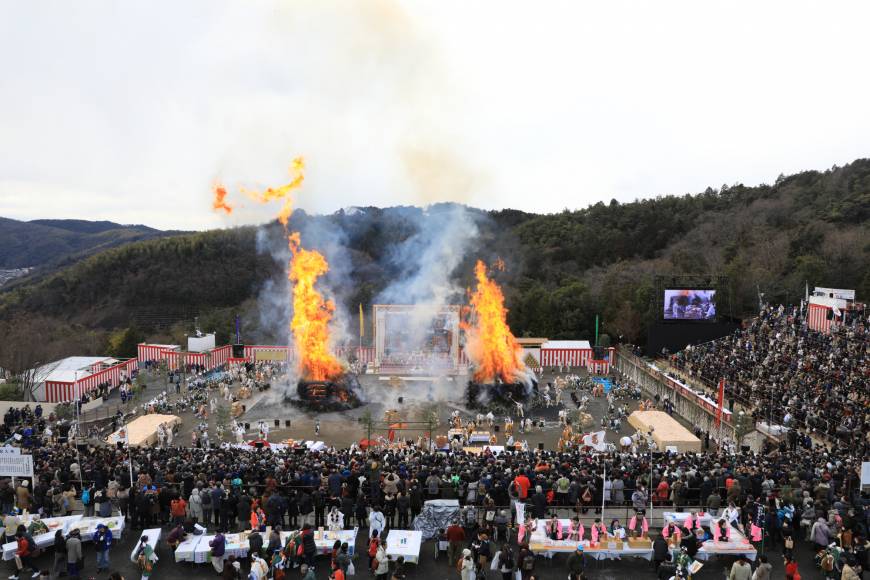
 Click to enlarge
Click to enlarge
